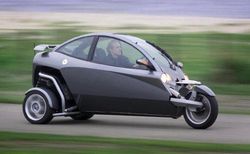.
Vandenbrink Carver: Difference between revisions
No edit summary |
No edit summary |
||
| Line 1: | Line 1: | ||
[[Image:Vandenbrink Carver.jpg|thumb|right|250px]] | [[Image:Vandenbrink Carver.jpg|thumb|right|250px]] | ||
The '''Carver''' is a | The '''Carver''' is a tilting three wheeled vehicle using an automatic balancing technology to balance the passenger compartment under all conditions. Its first commercial product, the '''Carver One''', seats two people, and is manufactured and distributed by '''Carver Europe''' (formerly named [[Vandenbrink]]) in the Netherlands. | ||
It looks like to be halfway between a | It looks like to be halfway between a motorcycle and a [[car]], and, like many [[microcar]]s, the Carver has three wheels and the controls of a normal car. The three wheel Carver One is said to have the comfort, controls and stability of a normal car while showing the dynamic cornering behaviour of a motorcycle. The Carver can be driven by anyone with a normal car driver's license in the European Union, though other countries outside of the EU may not allow this. In most countries the taxation often follows the motorcycle guidlines. | ||
The dimensions are 3.4 meters long by 1.3 m wide by 1.4 m high, giving it a low slim profile, similar to a motorcycle. It weighs only 640 kg (1400 lbs), about half the weight of a medium size car or three to four times the weight of most motorcycles. The Carver One can tilt up to 45 degrees while turning. This is not based on how far the wheel is rotated, but on how much cornering force is applied to it. | The dimensions are 3.4 meters long by 1.3 m wide by 1.4 m high, giving it a low slim profile, similar to a motorcycle. It weighs only 640 kg (1400 lbs), about half the weight of a medium size car or three to four times the weight of most motorcycles. The Carver One can tilt up to 45 degrees while turning. This is not based on how far the wheel is rotated, but on how much cornering force is applied to it. | ||
Revision as of 15:13, 23 December 2006
The Carver is a tilting three wheeled vehicle using an automatic balancing technology to balance the passenger compartment under all conditions. Its first commercial product, the Carver One, seats two people, and is manufactured and distributed by Carver Europe (formerly named Vandenbrink) in the Netherlands.
It looks like to be halfway between a motorcycle and a car, and, like many microcars, the Carver has three wheels and the controls of a normal car. The three wheel Carver One is said to have the comfort, controls and stability of a normal car while showing the dynamic cornering behaviour of a motorcycle. The Carver can be driven by anyone with a normal car driver's license in the European Union, though other countries outside of the EU may not allow this. In most countries the taxation often follows the motorcycle guidlines.
The dimensions are 3.4 meters long by 1.3 m wide by 1.4 m high, giving it a low slim profile, similar to a motorcycle. It weighs only 640 kg (1400 lbs), about half the weight of a medium size car or three to four times the weight of most motorcycles. The Carver One can tilt up to 45 degrees while turning. This is not based on how far the wheel is rotated, but on how much cornering force is applied to it.
The Carver has a 660 cc 4-cylinder 16-valve engine with a turbo intercooler giving a power output of 48 kW (or 65 bhp) at 7,500 rpm and a maximum torque of 100 Nm at 4.000 rpm. The transmission is a 5-speed manual with reverse, and all wheels are equipped with ventilated disk brakes. The front wheel is slightly larger than the rear wheels (at 17" to 15").
The Carver One has a top speed of 185 km/h. The acceleration of 0-100 km/h in 8.2 seconds, which is slow compared to most motorcycles, and average for a sports car (a Toyota Camry has a similar acceleration).
The unique property of the Carver One is its automatic balancing DVC (Dynamic Vehicle Control) system, which is said to allow full stability under almost all circumstances. Thanks to this DVC technology its cornering behaviour is said to feel natural and pleasant.
See also
- The T-Rex is similar vehicle produced in Canada however with a single wheel at the rear and side-by-side seating, and no self-balancing characteristics.

